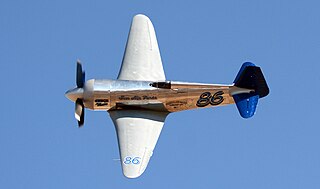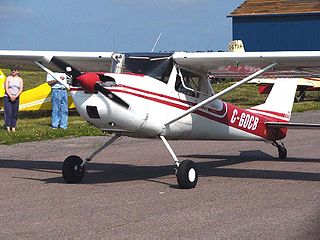
The Yakovlev Yak-11 is a trainer aircraft used by the Soviet Air Force and other Soviet-influenced air forces from 1947 until 1962.

The Yakovlev Yak-15 was a first-generation Soviet turbojet fighter developed by the Yakovlev design bureau (OKB) immediately after World War II. It used a reverse-engineered German Junkers Jumo 004 engine. Along with the Swedish Saab 21R, it was one of only two jets to be successfully converted from a piston-powered aircraft and enter production. 280 aircraft were built in 1947. Although nominally a fighter, it was mainly used to qualify piston-engine-experienced pilots to fly jets.
The Yakovlev Yak-44 was a proposed twin-turboprop Airborne Early Warning (AEW) aircraft, resembling the United States Navy's E-2 Hawkeye, intended for use with the Soviet Navy's Ulyanovsk class supercarriers. Along with the aircraft carrier it would have flown from, the Yak-44 was cancelled after the demise of the Soviet Union. A full-scale mockup with foldable wings was built.

The Yakovlev Yak-55 is a single-seat aerobatic aircraft. Pilots flying the Yak-55 have won several world aerobatic championships.

The Yakovlev Yak-30 was an experimental Soviet interceptor from the late 1940s. Derived from the Yak-25, from which it differed primarily in having wings sweptback 35° at quarter chord, the Yak-30 retained the fuselage, tail surfaces and undercarriage of the earlier fighter fundamentally unchanged.

The Yakovlev Yak-6 was a Soviet twin-engined utility aircraft, developed and built during World War II. It was used as a short-range light night bomber and a light transport.
The Yakovlev EG, also commonly known as the Yak-M11FR-1 and Sh (Shootka), was an experimental aircraft with coaxial rotors. The prototype was first flown by V.V. Tezavrovsky in December 1947.
The Yakovlev Yak-20 was an experimental piston-engined trainer developed in the Soviet Union in 1949. It did not go into production.
The Yakovlev Yak-53 was a single seat aerobatic trainer aircraft produced in the USSR during 1981/2. Only prototypes were produced.
The Yakovlev Yak-58 is a small, multi-role utility transport and business aircraft. The aircraft features a pusher engine and twin boom tail. It saw limited production in the late 1990s.

The Yakovlev Yak-8 was a Soviet utility aircraft developed during World War II. It was not accepted for production, but received the NATO reporting name "Crib" anyway.

The Yakovlev Yak-200 was a prototype Soviet multi-engine trainer built during the 1950s. A modified version was built as the Yak-210 for navigator training, but only one example of each was built before the program was cancelled in 1956.
The Yakovlev UT-3, initially known as the AIR-17 and then Ya-17, was a twin-engine low-wing monoplane aircraft designed by Alexander Sergeyevich Yakovlev for the Soviet Air Force (VVS).
The Yakovlev AIR-6 was a Soviet light utility aircraft of the 1930s. It was a single-engined high-wing monoplane designed by Alexander Sergeyevich Yakovlev, with 128 being built.

The Yakovlev AIR-7 was a prototype Soviet high performance light aircraft of the 1930s. It was a two-seat single-engined monoplane, which demonstrated excellent performance during testing. After the prototype almost crashed as a result of flutter, its designer, Alexander Sergeyevich Yakovlev suffered temporary disgrace and no production followed.
The Yakovlev Ya-19,, was a 5-seat light transport aircraft developed directly from the Yakovlev UT-3 during the late 1930s. The Ya-19 did not enter production, despite positive results from flight trials, due to the lack of development of the UT-3 and cancellation of the Voronezh MV-6 engine program, which were the result of changing priorities in the face of the Great Patriotic War.

TheYakovlev AIR-9 / AIR-9bis was a 2-seat sport aircraft designed and built in the USSR during the early 1930s.
The Yakovlev AIR-12 was a long-range sport aircraft designed and built in the Soviet Union during the late 1930s.
The Yakovlev Ya-21,, was a single-seat high-speed sport aircraft / fighter-trainer designed and built in the Soviet Union in the late 1930s.
















